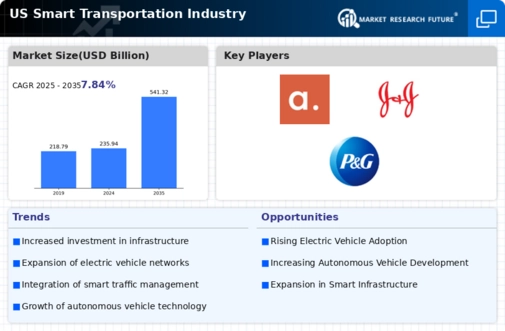Government Initiatives and Funding
Government initiatives play a pivotal role in shaping the smart transportation market. In the US, federal and state governments are increasingly investing in smart transportation projects, allocating billions of dollars to enhance infrastructure and promote innovative technologies. For instance, the Infrastructure Investment and Jobs Act has earmarked approximately $110 billion for roads, bridges, and public transit, which directly impacts the smart transportation market. These investments aim to improve safety, reduce congestion, and promote sustainability. Furthermore, various grants and funding programs are available to support local governments in implementing smart transportation solutions. This financial backing not only accelerates the adoption of advanced technologies but also encourages public-private partnerships, fostering innovation within the smart transportation market.
Urbanization and Population Growth
Urbanization and population growth are significant drivers of the smart transportation market. As more individuals migrate to urban areas, the demand for efficient and sustainable transportation solutions intensifies. The US is witnessing a trend where over 80% of its population resides in urban settings, leading to increased traffic congestion and pollution. This scenario necessitates the implementation of smart transportation systems that can optimize traffic flow and enhance public transit options. The smart transportation market is expected to benefit from this urban shift, as cities seek to integrate smart technologies to manage transportation challenges effectively. Moreover, the growing population is likely to drive investments in smart infrastructure, further propelling the market's expansion.
Environmental Concerns and Sustainability
Environmental concerns are increasingly influencing the smart transportation market. As awareness of climate change and pollution rises, there is a growing demand for sustainable transportation solutions. The US government has set ambitious targets to reduce greenhouse gas emissions, which directly impacts the smart transportation market. Initiatives promoting electric vehicles (EVs) and alternative fuels are gaining traction, with the aim of reducing the carbon footprint of transportation. In 2025, the market for electric vehicles is expected to surpass $100 billion, reflecting a shift towards greener alternatives. This emphasis on sustainability is prompting investments in smart transportation technologies that enhance energy efficiency and reduce environmental impact, thereby driving growth in the smart transportation market.
Consumer Demand for Enhanced Mobility Options
Consumer demand for enhanced mobility options is a crucial driver of the smart transportation market. As lifestyles evolve, individuals seek more convenient, efficient, and flexible transportation solutions. The rise of ride-sharing services and on-demand transportation reflects this shift in consumer preferences. In the US, the ride-sharing market is projected to reach $100 billion by 2025, indicating a strong inclination towards alternative mobility options. This demand encourages the development of smart transportation systems that integrate various modes of transport, providing seamless connectivity for users. Additionally, consumers are increasingly prioritizing safety and reliability, prompting investments in technologies that enhance the overall travel experience. This growing demand for enhanced mobility options is likely to propel the smart transportation market forward.
Technological Advancements in Mobility Solutions
Technological advancements are revolutionizing the smart transportation market. Innovations such as connected vehicles, real-time data analytics, and advanced traffic management systems are transforming how transportation operates. The integration of Internet of Things (IoT) devices enables seamless communication between vehicles and infrastructure, enhancing safety and efficiency. In 2025, the smart transportation market is projected to reach a valuation of over $200 billion, driven by these technological advancements. Companies are increasingly focusing on developing mobility-as-a-service (MaaS) platforms, which offer integrated transportation solutions to consumers. This shift towards technology-driven mobility solutions is likely to reshape the landscape of the smart transportation market, making it more accessible and user-friendly.













Leave a Comment